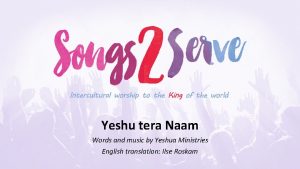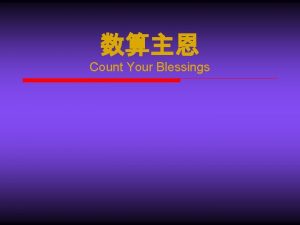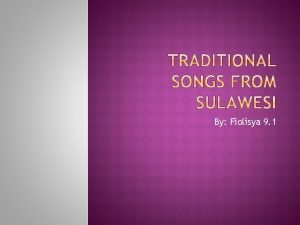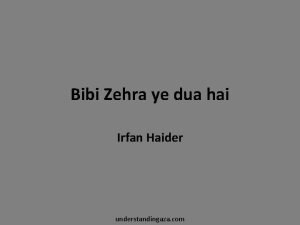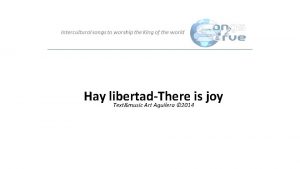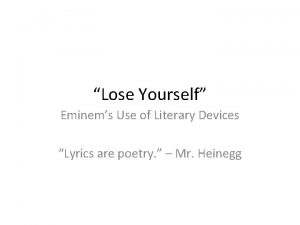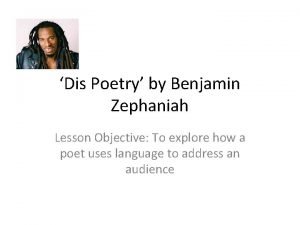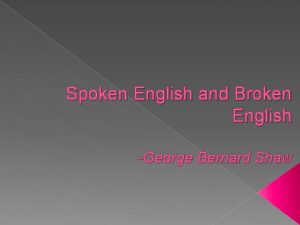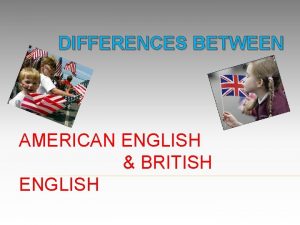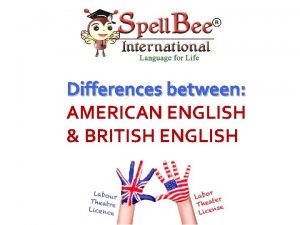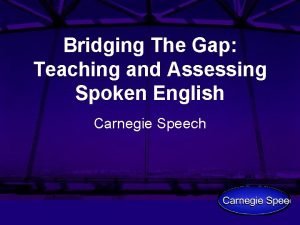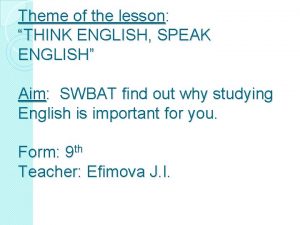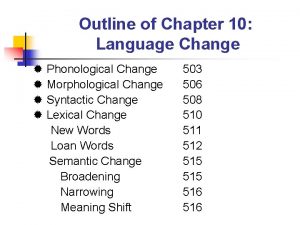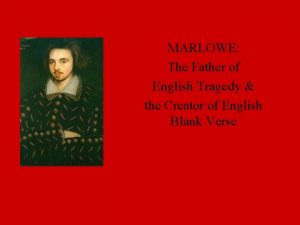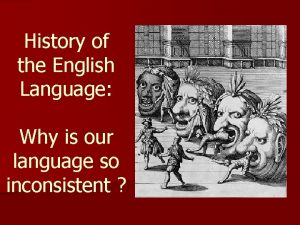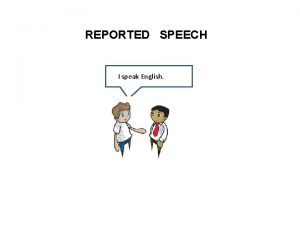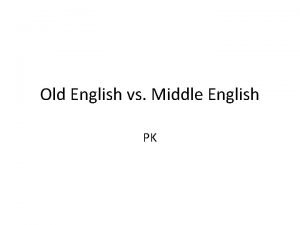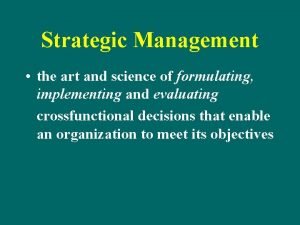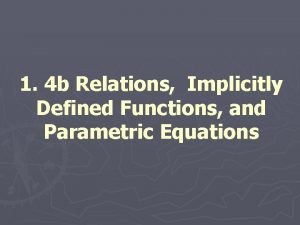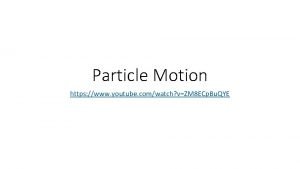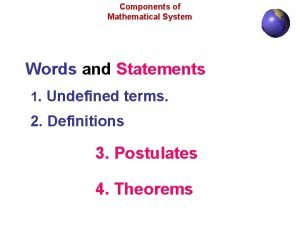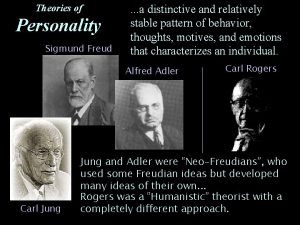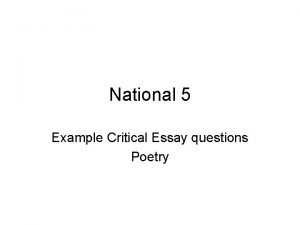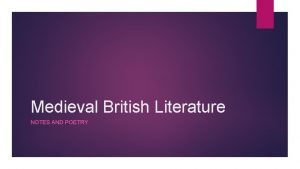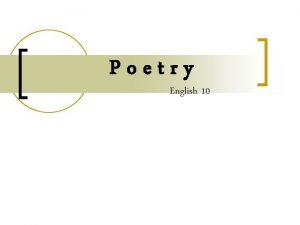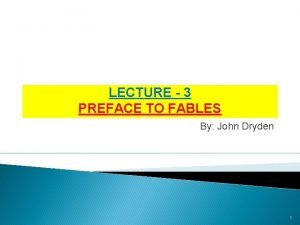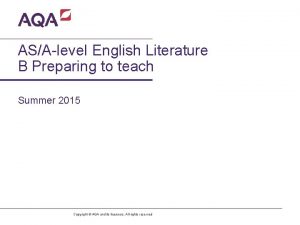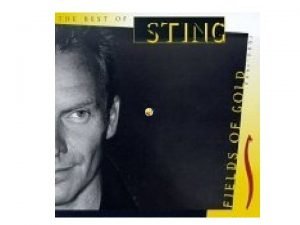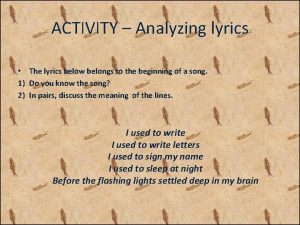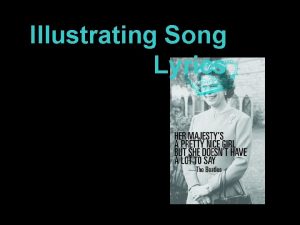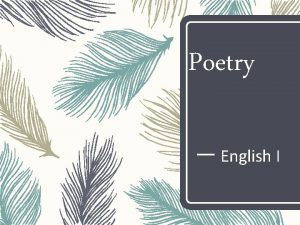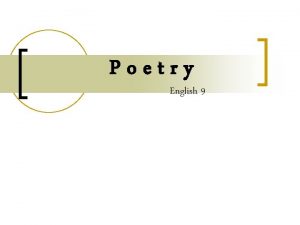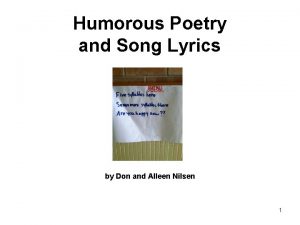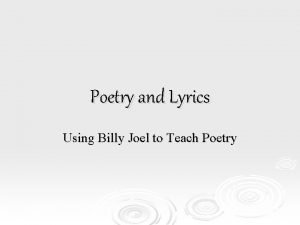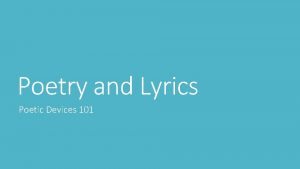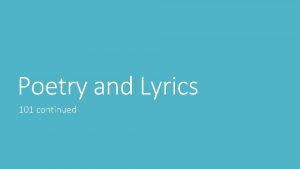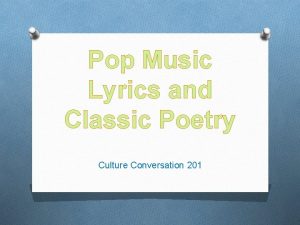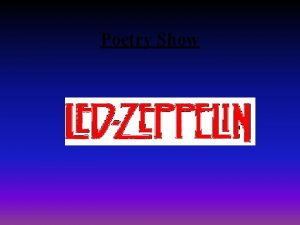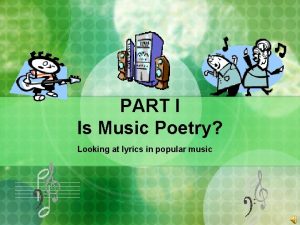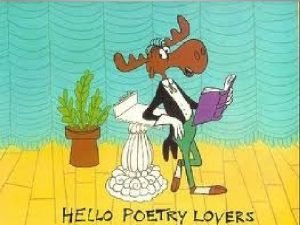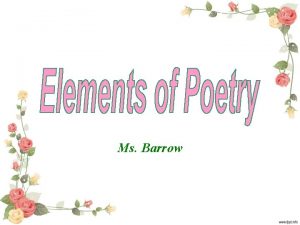Poetry and Lyrics English 10 Poetry Defined Poetry






































- Slides: 38

Poetry and Lyrics English 10

Poetry Defined Ø Poetry is… a type of literature that expresses ideas, feelings, or tells a story in a specific form (usually using lines and stanzas) Ø Is often defined by or considered to have euphony, or beautiful sound Ø

Guidelines 1. 2. 3. 4. Read the poem aloud several times, following the punctuation for phrasing, listening to the rhythms, and paying attention to the emotional effect. Respond thoughtfully to key words and references. Many words have both denotative and connotative meanings. Write a paraphrase of any lines that need clarification or simplification. Using your own response to the poem, write a statement clarifying the central meaning.

Point of View l Poet – author of the poem l Speaker – narrator of the poem, the intended performer of the poem l Audience – those that hear or read the poem, also those for which the poem was intended

Tone Poets communicate meaning through tone – that is, through the attitudes they take toward their subject matter or audience. Three poets can write on the same topic and display three distinctly different attitudes. Unlike vocal communications, poems cannot express tone through inflection, volume, and pitch. Poets may indicate tone through their word choice, the arrangement of words, by rhythm, sound, images, and figures of speech.

Poetry Structure l FORM - the appearance of the words on the page l LINE - a group of words together on one line of the poem l STANZA - a group of lines arranged together A word is dead When it is said, Some say. I say it just Begins to live That day.

Stanzas Couplet = Triplet (Tercet)= Quatrain = Quintet = Sestet (Sextet) = Septet = Octave = a two line stanza a three line stanza a four line stanza a five line stanza a six line stanza a seven line stanza an eight line stanza

Auditory Elements

Rhythm & Tone l The pattern created by the sounds of the words in a poem. l Rhythm can be created by meter, rhyme, alliteration and refrain. l Tone – the intended attitude through voice, inflection, etc.

Meter Ø A pattern of stressed and unstressed syllables. Ø Meter occurs when the stressed and unstressed syllables of the words in a poem are arranged in a repeating pattern. When poets write in meter, they count out the number of stressed (strong/accented) syllables and unstressed (weak) syllables for each line. They repeat the pattern throughout the poem. A “foot” is a single unit of meter. Ø Ø

Meter Continued l l l FOOT - unit of meter. A foot can have two or three syllables. Usually consists of one stressed and one or more unstressed syllables. l TYPES OF FEET The types of feet are determined by the arrangement of stressed and unstressed syllables. (cont. )

Types of Meter TYPES OF FEET (cont. ) Iambic - unstressed, stressed Trochaic - stressed, unstressed Anapestic - unstressed, stressed Dactylic - stressed, unstressed

Meter Cont. Kinds of Metrical Lines l l l l monometer dimeter trimeter tetrameter pentameter hexameter heptameter octometer = = = = one foot on a line two feet on a line three feet on a line four feet on a line five feet on a line six feet on a line seven feet on a line eight feet on a line

Poetic Devices Enjambment – When the poet continues a sentence without a pause beyond the end of a line, couplet, or stanza l Anaphora - the repetition of a word or phrase at the beginning of successive clauses, lines, or ideas l

Rhyme l Words sound alike because they share the same ending vowel and consonant sounds. End Rhyme l Internal Rhyme l Near Rhyme l

End Rhyme l A word at the end of one line rhymes with a word at the end of another line Hector the Collector Collected bits of string. Collected dolls with broken heads And rusty bells that would not ring.

Internal Rhyme l A word inside a line rhymes with another word on the same line. Once upon a midnight dreary, while I pondered weak and weary. From “The Raven” by Edgar Allan Poe

Near Rhyme l a. k. a imperfect rhyme, close rhyme l The words share EITHER the same vowel or consonant sound BUT NOT BOTH ROSE LOSE Different vowel sounds (long “o” and “oo” sound) á Share the same consonant sound á

Rhyme Scheme l A rhyme scheme is a pattern of rhyme (usually end rhyme, but not always). l Use the letters of the alphabet to represent sounds to be able to visually “see” the pattern. (See next slide for an example. )

Sample Rhyme Scheme The Germ by Ogden Nash A mighty creature is the germ, Though smaller than the pachyderm. His customary dwelling place Is deep within the human race. His childish pride he often pleases By giving people strange diseases. Do you, my poppet, feel infirm? You probably contain a germ. a a b b c c a a

Literary Devices l Onomatopoeia Words that imitate the sound they are naming BUZZ OR sounds that imitate another sound “The silken, sad, uncertain, rustling of each purple curtain. . . ” (The sound synthesizes rustling curtains)

Literary Devices Cont’d. l ALLITERATION l Consonant sounds repeated at the beginnings of words If Peter Piper picked a peck of pickled peppers, how many pickled peppers did Peter Piper pick? l CONSONANCE l l Similar to alliteration EXCEPT. . . The repeated consonant sounds can be anywhere in the words – often creates near rhyme and onomatopoeia “He struck a streak of bad luck. ” “silken, sad, uncertain, rustling. . “

Literary Devices Cont’d. l Assonance - Repeated VOWEL sounds in a line or lines of poetry. (Often creates near rhyme) Lake Fate Base Fade (All share the long “a” sound) l Cacophony – Unpleasantness of sound l l Often created by assonance, or long vowel sounds Refrain - A sound, word, phrase or line repeated regularly in a poem.

Lyric A short poem l Usually written in first person point of view l Expresses an emotion or an idea or describes a scene l Do not tell stories and are often melodic l l Many of the poems we read will be lyric

Narrative l l l Can be short or lengthy Is written in either third or first person Describes an event or experience and tells a story (plot, character development) Examples of Narrative Poems: “The Raven” “The Highwayman” “Casey at the Bat” “The Walrus and the Carpenter”

Figurative Language l Simile l A comparison of two things using “like”, “as”, “than”, ” or “resembles. ” l “She is as beautiful as a sunrise. ” Shrek: Ogres are like onions. Donkey: They stink? Shrek: Yes. No! Donkey: They make you cry? Shrek: No! Donkey: You leave them out in the sun, they get all brown, start sprouting little white hairs? Shrek: No! Layers! Onions have layers! (Shrek, 2001)

Figurative Language Cont’d. l Metaphor l A direct comparison of two unlike things “All the world’s a stage, and we are merely players. ” • - William Shakespeare Implied Metaphor • “He took his final bow before the curtain fell on his life. ” (Implies the world as a stage)

Figurative Language Cont’d l Conceit l An extended metaphor that goes several lines or possible the entire length of a work. (can be an allegory) l Ex. Message in a Bottle “I’m sending out an S. O. S. ” l l The Police Hyperbole l Exaggeration often used for emphasis. “So much depends on a red wheel barrow…”

Figurative Language Cont’d l Litotes (Lī-tō-tēz) l Using double negative to describe an object’s trait l l Understatement l Giving less weight in description to object, action, etc. l l Ex. “She’s not unattractive” Ex. Phoenix is fairly warm in July. Idiom l An expression where the literal meaning of the words is not the meaning of the expression. It means something other than what it actually says. l Ex. It’s raining cats and dogs.

Figurative Language Cont’d l Personification l An animal given human-like qualities or an object given life-like qualities. l Examples?

Other Literary Devices l Allusion comes from the verb “allude” which means “to refer to” l An allusion is a reference to something famous. l l Event l Place l Story or Character l Person l Etc.

Other Literary Devices l Imagery/Sensory Detail Language that appeals to the senses. l Most images are visual, but they can also appeal to the senses of sound, touch, taste, or smell. l Also used to evoke emotional response (pathos) l

TP-CASTT l l l Title – What do you think the poem will be about? Paraphrase – What basically happens in the poem? Connotation – What figurative language exists in the poem? Attitude – Describe the mood and tone. Shift – Is there a shift in subject or tone? l l Sound – Does the poet use any sound devices? Structure – What form does the poem take? Title – After reading the poem, what does the title mean? Does it have new meaning? Theme – What is one common human experience that this poem explores?

“Interior” Her mind lives in a quiet room, A narrow room and tall, With pretty lamps to quench the gloom And mottos on the wall. There all things are waxen neat And set in decorous lines; And there are posies round and sweet , And little straightened vines. Her mind lives tidily; apart From cold and noise and pain, And bolts the door against her heart, Out wailing in the rain. Dorothy Parker 1893 - 1967

TPCASTT l Title – I think the poem will be about the inside of l Paraphrase – Look at rhyme scheme, punctuation, ideas, and summarize them to paraphrase the poem. something. Something not easily seen perhaps? Comfort, design, etc? l In the poem, a person’s mind is personified by being able to live in a beautiful room. It is also well organized and “tidy” with elements of nature in it. The heart is also personified and is stuck outside of the beautiful room in a cold and dark environment.

TPCASTT l Connotation – Positive and comforting imagery is l Attitude – The tone is confusion and isolation, and offered with words like “pretty”, “decorous”, “sweet”, and “straightened”. However, these are contradicted by words like “cold” and “noise” and “pain” in the second ½ of the poem. There is a clear metaphor/personification of her mind as living in a room (her head/a place of imagination) as well as her heart “out in the rain” the mood is worried and/or fearful. How?

TPCASTT l Shift – There is a definite shift in tone in line 9 l Sound – There is end line rhyme used throughout the l Structure – It’s one stanza of 12 lines; 6 couplets, l Title – “Interior” refers to what is going on inside a l Theme – There is a common human tendency to not beginning with the word “apart”. poem. This is pleasant at first, but it switches to being more intense in the latter ½. The beginning is more euphonic while the ending is more cacophonic. and has a meter of between 6 & 8 syllables per line. young girl’s mind. let our emotions impair our judgment in logical decision making, but there is a fine line between that and living in denial. Other interps?

Explication for “Interior”, by Dorothy Parker, is a poem that explores the relationship between our heartfelt emotions and our mind. Parker uses an abundance to personification to characterize the heart and the mind. The mind “lives in a quiet room” and the heart is “out wailing in the rain”. The pretty room and the rainy environment are juxtaposed against one another to show a separation between the heart and mind. There is an identifiable meter and rhythm in the poem which starts out euphonic. This is appropriate to match the “pretty” interior of the room. The tone shifts towards the end with more cacophonic sounds to match the darker imagery that Parker presents. Essentially, Parker is trying to show that there is a common human tendency to not let our emotions impair our judgment in logical decision making, but there is a fine line between that and living in denial.
 What is the collection of well-defined objects
What is the collection of well-defined objects Yeshu tera naam lyrics in english
Yeshu tera naam lyrics in english Count your blessings lyrics in english
Count your blessings lyrics in english Mon dieu, tu es grand, tu es beau paroles pdf
Mon dieu, tu es grand, tu es beau paroles pdf Sayang sayang si patokaan lirik
Sayang sayang si patokaan lirik Lyrics of bibi zehra ye dua hai
Lyrics of bibi zehra ye dua hai There is joy art aguilera
There is joy art aguilera Snap back to reality lyrics
Snap back to reality lyrics Dis poetry
Dis poetry Spoken english and broken english summary
Spoken english and broken english summary American vs english words
American vs english words Differences between american and british english vocabulary
Differences between american and british english vocabulary Spoken english and broken english summary
Spoken english and broken english summary British english vs american english
British english vs american english Toe and heel dance
Toe and heel dance Narrative vs lyric poem
Narrative vs lyric poem Speak theme
Speak theme Semantic change
Semantic change The father of tragedy
The father of tragedy Old english vs modern english
Old english vs modern english Old english vs modern english
Old english vs modern english “i speak english” he said that he ……english
“i speak english” he said that he ……english Old pronouns
Old pronouns What can be defined as the art and science of formulating
What can be defined as the art and science of formulating Find two functions defined implicitly by the given relation
Find two functions defined implicitly by the given relation Youtube https //www.youtube.com/watch v=vnp84pn0mjq
Youtube https //www.youtube.com/watch v=vnp84pn0mjq Mathematical system components
Mathematical system components Is defined as a distinctive and relatively stable pattern
Is defined as a distinctive and relatively stable pattern Etvx examples
Etvx examples Customer defined service standards
Customer defined service standards Nat 5 critical essay questions poetry
Nat 5 critical essay questions poetry Medieval poetry in english literature
Medieval poetry in english literature Flower poetry in english
Flower poetry in english Edexcel gcse english literature past paper
Edexcel gcse english literature past paper Allama iqbal philosophy of education
Allama iqbal philosophy of education Simile definition
Simile definition Preface to the fables summary
Preface to the fables summary English romanticism characteristics
English romanticism characteristics Social and political protest writing examples
Social and political protest writing examples

